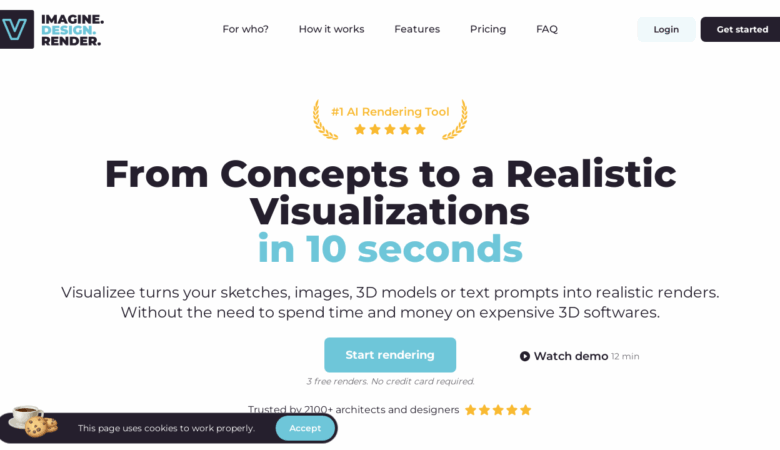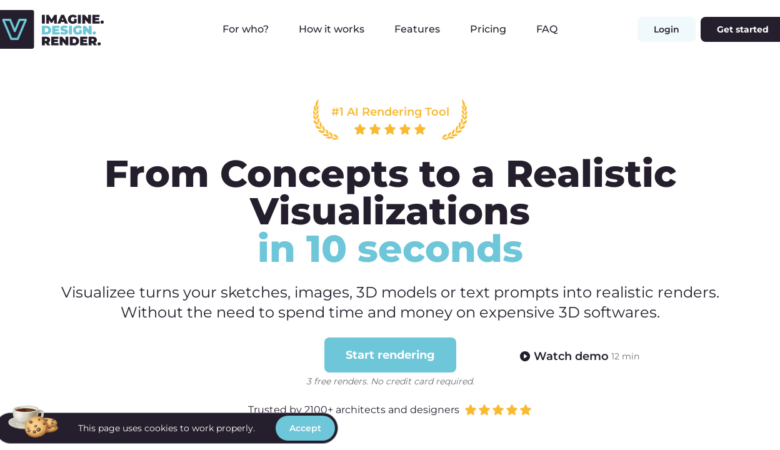Imagine entering a world in which producing 3D objects just requires outlining your vision. Hyper3D exactly is what I mean.AI brings something! Leveraging the amazing power of artificial intelligence, this game-changing platform is transforming the creation of digital entertainment. Come see as we investigate Hyper3D.From architectural visualisation to game creation, artificial intelligence is revolutionising sectors; find how it might change your creative process.
What is Hyper3D.AI?
Designed to simplify the creation of premium 3D assets, Hyper3D.AI is a creative AI-powered 3D model generating tool. Hyper3D.AI lets users create intricate 3D models from basic text descriptions or 2D photographs by using advanced machine learning algorithms, therefore drastically saving the time and effort needed in conventional 3D modelling processes.
Key Features of Hyper3D.AI
Text-to-3D Generation: Users can input detailed text descriptions to generate corresponding 3D models, making it easier for non-technical team members to contribute to the 3D asset creation process.
Image-to-3D Conversion: The platform can analyze 2D images and convert them into 3D models, opening up new possibilities for rapid prototyping and concept visualization.
AI-Assisted Texturing: Hyper3D.AI incorporates intelligent texturing capabilities, automatically applying realistic materials and textures to generated models.
Customizable Output Formats: The generated 3D models can be exported in various industry-standard formats, ensuring compatibility with popular 3D software suites.
Cloud-Based Processing: By utilizing cloud computing resources, Hyper3D.AI can handle complex computations without requiring high-end hardware on the user’s end.
How Hyper3D.AI is Changing the 3D Modeling Landscape
The introduction of AI-powered tools like Hyper3D.AI is reshaping the 3D modeling industry in several ways:
Democratizing 3D Content Creation
By lowering the technical barrier to entry, Hyper3D.AI is making 3D modeling more accessible to a wider range of creators. This democratization of 3D content creation could lead to an explosion of innovative designs and applications across various fields.
Accelerating Production Pipelines
Rapid generation of 3D assets from text or images can greatly accelerate manufacturing processes in sectors such game development, cinema, and advertising. Faster iterative cycles and more effective resource allocation could follow from this acceleration.
Enhancing Collaboration Between Designers and Non-Technical Stakeholders
Hyper3D.AI’s intuitive interface and text-based input system facilitate better communication between designers and non-technical team members or clients. This improved collaboration can result in more accurate representations of conceptual ideas and faster approval processes.
Practical Applications of Hyper3D.AI
The versatility of Hyper3D.AI makes it suitable for a wide range of applications across different industries:
Game Development
Game developers can use Hyper3D.AI to quickly prototype environments, characters, and props. This rapid asset generation capability allows for more experimentation and iteration during the early stages of game design.
Architectural Visualization
Architects and interior designers can leverage Hyper3D.AI to create detailed 3D models of buildings and spaces based on written descriptions or rough sketches. This can streamline the process of presenting concepts to clients and stakeholders.
E-commerce and Product Visualization
Online retailers can utilize Hyper3D.AI to generate 3D models of products, enabling interactive 360-degree views and augmented reality experiences for customers. This enhanced visualization can lead to improved customer engagement and potentially higher conversion rates.
Film and Animation Pre-production
Storyboard artists and concept designers in the film and animation industry can use Hyper3D.AI to quickly visualize scenes and characters in 3D, facilitating better communication of ideas to directors and production teams.
Virtual and Augmented Reality Content Creation
As the demand for VR and AR content grows, Hyper3D.AI can serve as a valuable tool for rapidly populating virtual environments with diverse and detailed 3D assets.
Technical Deep Dive: How Hyper3D.AI Works
At its core, Hyper3D.AI utilizes a combination of advanced machine learning techniques to achieve its impressive results:
Natural Language Processing (NLP)
The text-to-3D generation feature relies on sophisticated NLP algorithms to interpret and understand the user’s text descriptions. This involves parsing the input for key attributes such as shape, size, color, and texture.
Generative Adversarial Networks (GANs)
Hyper3D.AI employs GANs to generate the initial 3D model based on the interpreted text or image input. These neural networks work in tandem to create and refine the 3D structure until it closely matches the desired output.
Computer Vision Algorithms
For image-to-3D conversion, Hyper3D.AI uses state-of-the-art computer vision algorithms to analyze 2D images, detect depth and perspective, and reconstruct the 3D geometry of the objects in the image.
Procedural Generation Techniques
To enhance the detail and realism of the generated models, Hyper3D.AI incorporates procedural generation techniques. These algorithms can automatically add intricate details, textures, and variations to the base models.
Comparison with Similar AI Tools
While Hyper3D.AI offers impressive capabilities, it’s essential to consider how it stacks up against other AI-powered 3D modeling tools in the market:
Hyper3D.AI vs. Meshy.AI
Meshy.AI is another popular AI-driven 3D model generator that has gained traction in the industry. Here’s how Hyper3D.AI compares:
Speed: Hyper3D.AI generally offers faster generation times for complex models compared to Meshy.AI.
Texture Quality: Meshy.AI is known for its high-quality texturing capabilities, which are on par with or slightly better than Hyper3D.AI in some cases.
User Interface: Hyper3D.AI provides a more intuitive and user-friendly interface, making it easier for beginners to get started.
Export Options: Both platforms offer a wide range of export formats, but Hyper3D.AI edges out with support for more specialized industry-specific formats.
Hyper3D.AI vs. 3D AI Studio
3D AI Studio is another contender in the AI-powered 3D modeling space. Here’s how it compares to Hyper3D.AI:
Model Complexity: Hyper3D.AI excels in generating more complex and detailed models, especially for organic shapes and characters.
Customization: 3D AI Studio offers more granular control over the generated models, allowing for easier post-generation tweaks.
Integration: 3D AI Studio has better integration with popular 3D software suites, while Hyper3D.AI focuses more on standalone functionality.
Learning Curve: Hyper3D.AI has a gentler learning curve, making it more accessible to newcomers in the 3D modeling field.
Hyper3D.AI vs. Hunyuan3D
Hunyuan3D, developed by Tencent, is known for its focus on generating realistic human characters. Comparing it to Hyper3D.AI:
Specialization: Hunyuan3D excels in creating human models, while Hyper3D.AI offers more versatility across different types of 3D assets.
Realism: For human characters, Hunyuan3D often produces more photorealistic results, but Hyper3D.AI performs better for a broader range of objects and scenes.
Accessibility: Hyper3D.AI is more readily available and easier to use for individual creators, while Hunyuan3D is often integrated into larger production pipelines.
Performance: Hyper3D.AI generally offers faster generation times and requires less powerful hardware to run effectively.
The Future of AI-Powered 3D Modeling
As AI technology continues to advance, we can expect tools like Hyper3D.AI to become even more sophisticated and integral to the 3D modeling workflow. Some potential future developments include:
Enhanced Real-time Collaboration
Future versions of AI-powered 3D modeling tools may incorporate real-time collaboration features, allowing multiple users to work on the same project simultaneously, with AI assisting in merging and optimizing contributions.
Improved Physical Simulation
Integration of advanced physics engines could allow AI-generated models to have more accurate physical properties, making them immediately suitable for use in simulations and interactive environments.
AI-Driven Optimization and LOD Generation
As 3D models become more complex, AI could play a crucial role in automatically optimizing geometry and generating level-of-detail (LOD) versions for improved performance across different platforms.
Cross-platform and Cross-medium Adaptation
Future AI tools might be able to automatically adapt 3D models for use across different platforms (e.g., high-end PC, mobile devices, VR headsets) or even translate them into different mediums (e.g., 3D printing, holographic displays).
Challenges and Considerations
While Hyper3D.AI and similar tools offer exciting possibilities, there are some challenges and considerations to keep in mind:
Copyright and Intellectual Property Concerns
As AI-generated content becomes more prevalent, questions about copyright and ownership of the generated 3D models may arise. It’s important for users to understand the licensing terms and potential limitations of using AI-generated assets in commercial projects.
Balancing Automation with Artistic Control
While AI can significantly speed up the 3D modeling process, there’s a delicate balance to strike between automation and maintaining artistic control. Professionals may need to adapt their workflows to incorporate AI tools effectively without sacrificing their unique creative vision.
Technical Limitations and Edge Cases
Hyper3D.AI may find difficulty with some intricate or extremely specific 3D modelling jobs notwithstanding its superior features. Users should be aware of these constraints and ready to add conventional modelling approaches to AI-generated models as needed.
Ethical Considerations in AI-Generated Content
As AI becomes more involved in the creative process, it’s crucial to consider the ethical implications of using AI-generated content, particularly in sensitive applications or when representing real people or cultures.
In conclusion, Hyper3D.AI represents a significant leap forward in the field of AI-powered 3D modeling. By combining advanced machine learning techniques with an intuitive user interface, it has the potential to revolutionize workflows across various industries. As the technology continues to evolve, we can expect even more impressive capabilities and applications in the future of 3D content creation.










